South American Research at the Institute of Archaeology
The Institute of Archaeology has been engaged in South American Archaeology since 1967, when Warwick Bray was appointed as Lecturer (and later Professor) of Latin American Archaeology. This was the first position of its kind at a British University, and, as well as pursuing his own research (particularly in Colombia), Warwick supported a significant number of students working in Peru, including George Bankes, Jane Feltham, Ian Farrington, David Drew, Mike Czwarno, Frank Meddens, Alexandra Morgan, Tim Holden and Gill Hey. Today, the Institute continues to have many staff involved in South American research: Marcos Martinon-Torres, Thilo Rehren, John Merkel, Renata Peters, Jose Oliver, Manuel Arroyo-Kalin, Simon Hillson and several Graduate Research Students. One of Warwick’s students, Ann Kendall, completed her PhD thesis on Inca architecture in 1974, after which the Institute became the academic sponsor of Kendall’s Cusichaca Project (Kendall 2005). Between 1976 and 1984, the Cusichaca Project provided an important fieldwork opportunity for hundreds of British and Peruvian students, many of whom still work in universities, commercial archaeology and in the heritage sector. Sara Lunt’s 1987 PhD, also supervised by Warwick, researched the pottery at Cusichaca and included a collaboration with Rob Ixer to provide a petrographic characterisation of the pottery fabrics (Ixer and Lunt 1991). Bill Sillar also worked on the Cusichaca project and studied at the Institute of Archaeology with Warwick. Much of his research has focused on the ethnography of Andean pottery production and the archaeology of Inca state development (e.g. Sillar 2000, Sillar et al 2013).
Ixer, Lunt and Sillar are now collaborating on research into how craft production changed as Cuzco was transformed into the centre of Inca imperial administration. This current article summarises and develops work presented in Ixer, Lunt and Sillar (2014) and, by including analysis of new source material, strengthens one hypothesis concerning the transfer of ceramic technology from pre-Inca pottery production to that of the Inca state.
Introduction
The Inca Empire stretched from the borders of modern Colombia into Argentina and Chile, a territory comparable to that of the Roman Empire. The period of imperial expansion appears to have been very short, starting little more than a century before the Spanish Conquest in 1532. But survey evidence shows that, for some two centuries prior to imperial expansion, the Cuzco region was an active area with diverse settlements sharing and exchanging similar ceramics, which were often used in feasting and communal drinking (Bauer 2004). A major research question is how this region became united to form the Inca state, developing the social and economic structures and material culture of a colonizing Empire. One feature of this was a change in the production of pottery, with the development of new, high-quality wares for state sponsored activities. Research into the materials and technological origins of these ceramics can inform our understanding of the social and economic processes at a crucial stage of state development.
The high-quality Inca period pottery from the Cuzco region (Fig. 1) includes a group made from a distinctive clay body. In thin-section, the predominant inclusions are identified as andesite and evidence suggests that this is temper, added to the clay by the potters (Ixer and Lunt 1991). This andesite-tempered fabric (hereinafter the ‘ATF’) was used to make the polychrome pottery defined stylistically as ‘Cuzco Inca’ by John Rowe (1944, 47–49). Although other fabrics were also used for these wares (Ixer and Lunt 1991, 152, 162), Cuzco Inca pottery with the ATF is noteworthy for the standardisation of the fabric, the very high quality of the wares and the scale of production, thus marking a step-change in the ceramic repertoire of the region. This pottery played an essential role in many areas of Inca state activity, including the presentation of maize beer (chicha) during state organised work projects, the enactment of state rituals, use within Inca elite residences, and as gifts for the elite of other ethnic groups brought into the Inca Empire (Matos 1999, Bray 2003).
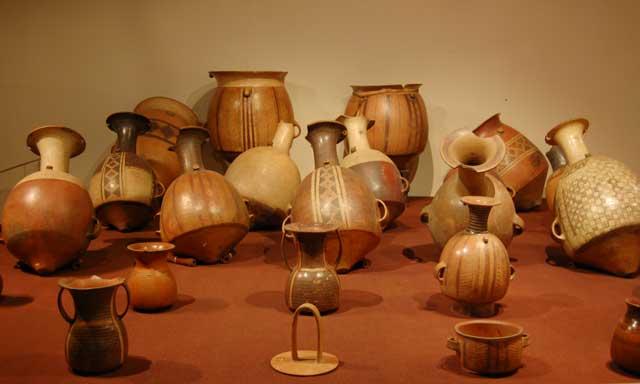
A display of classic Inca pottery in the Museum of the Universidad de San Antonio Abad del Cuzco. The largest vessels are around 1.20 meters tall from conical base to flaring rim.
Although its standardisation and quality are innovative, some of the decorative, formal and technical features of Cuzco Inca pottery can be identified in the pre-Inca wares of the south-central Andes. Killke pottery, in particular, has long been considered a precursor to Inca pottery (Rowe 1944). However, there are important elements of Cuzco Inca wares that are not found in Killke, including the very large size of some of the vessels (Chatfield 2007, 75) and, most significantly here, the exclusive use of one specific rock type, andesite, for the temper. Potters add temper, a non-plastic material, to alter the behaviour of naturally-occurring clays: this improves the workability of the clay body (fabric), helps promote the even drying of the pots, facilitates the movement of steam and gases through the clay during firing, and alters the performance characteristics of the fired vessel. Many types of material can be used as tempering agents: the specific choice of andesite as temper in Cuzco Inca ceramics may be highly informative about the socio-politics and power of the emerging Inca Empire.
To examine why the Inca used andesite in their pottery, this paper presents two groups of evidence. These indicate, first, that another pre-Inca ware, Lucre, along with Killke, contributed to the development of Cuzco Inca pottery. Secondly, the geological sources of andesite temper in Inca and Lucre pottery can be broadly identified. Andesite from this geological formation was also used for Inca buildings in Cuzco.
Pre-Inca and Inca Pottery in the Cuzco Region
The production of Killke pottery began in the Late Intermediate Period (c1000AD – c1400AD). Stratigraphically, it occurs in contexts underlying Inca deposits, sometimes continuing through them, and there is some evidence that production continued into the colonial period (Lunt 1987, Chatfield 2007). It is the dominant ceramic of the pre-Inca period in the valley of Cuzco and both Killke pottery itself, and a whole family of ‘Killke-related’ wares, are distributed throughout the Cuzco region.
The relationship between Killke and Cuzco Inca pottery was discussed by John Rowe (1944, 61), who identified the ‘Killke Series’ as ‘Early Inca’ on the basis of stylistic similarities, distribution and relative date. This assumption still has currency, underpinning recent work on the significance of Killke for studying the emergence of the Incas (summarised in Bauer 2004, 74–75).
Killke fabric technology was based on the use of a clean clay, tempered with a limited range of medium-grained, feldspathic rocks, similar in appearance to one another; there was no andesite. The Killke fabrics form a fairly coherent group, representing a common technological tradition, although the pots were probably produced in several workshops (Ixer and Lunt 1991, 156). The Killke fabric preparation technique – the use of a clean clay and the addition of plentiful temper from a limited range of rocks - is comparable to that of the ATF. Killke wares were coil-built. The forms include open bowls and jars, some of constricted form. They were painted in reds, black and, very occasionally, white, in freely-executed rectilinear motifs built into patterns arranged vertically and diagonally on the body of the pot, and then polished. They were sometimes modelled: the ‘face-neck’ type. The pots were fired in oxidising conditions (Ixer and Lunt 1991, 140–1).
‘Cuzco Inca’ pottery (also called ‘Imperial Inca’, ‘Classical Inca’ or ‘Inca Fine Wares’) was made during the Late Horizon Period (c1400AD – 1532AD). It was made in or around Cuzco, the capital of the Inca Empire, to judge by the quantity found there and the occurrence of shapes and designs unknown elsewhere. The pottery is highly-recognisable, very standardised in technology, form and design and of excellent quality. This is all in marked contrast to earlier wares and to other Late Horizon wares of the region and suggests a unique level of production control. The sudden appearance of these wares in the archaeological record and their ubiquity in elite, administrative and ritual Inca contexts, (Farrington 2013), gives credence to the widely-held view that Cuzco Inca pottery was a political artefact, created by the Inca state for the benefit of the Inca elite and their favoured clients, and that its production was state-controlled. The Cuzco Inca style was also highly influential in the subsequent development of pottery-making across the Inca Empire, where ‘provincial Inca’ wares, based on a selection of Cuzco prototypes, were produced in state-controlled potteries.
Rowe’s descriptions of Cuzco Inca pottery identified seven stylistic sub-groups, which together he called the Cuzco Series (Rowe 1944, 60). The fabric (‘paste’) was also described (Rowe 1944, 47). This fabric, the ATF, has been studied in detail subsequently (Ixer and Lunt, 1991: Ware 13). It is highly standardised, based on very clean clay with few accessory minerals and tempered with andesite in uniform sizes, shapes and quantities throughout the samples. Although other fabrics were also used to make Cuzco Inca pottery, the ATF predominates. The pottery was coil-built. The forms are made in a range of modular sizes and include the pointed-based, long-necked aryballus, wide-mouthed storage vessels and small plates and bowls. It was painted, predominantly with small rectilinear motifs, using similar colours and designs to Killke, but the Cuzco Inca decoration is of a markedly higher standard, with precise and richly-textured patterns built up using thick coloured slips across the body of the pot; and with the surfaces being highly burnished to a smooth, sometimes mirror-like, finish. In cross-section, sherds have a uniform grey core, revealing a consistent pyrotechnology, initially reduction with a final phase of oxidation to enhance the surface decoration.
Lucre pottery (Fig. 2) is the least-well known of the three wares described here (see Bauer 2004, 75 and references). It has been found in high concentrations at the site of Chokepukio, 25 kms south-east of Cuzco and close to Rumiqolqa (see below); sherds also appear elsewhere, as at Cusichaca, 80kms north-west of Cuzco, but they are very rare and their identification is hampered by the lack of a comprehensive characterisation (but see Chatfield 2007). The pottery was produced during the Late Intermediate Period (and possibly later): at Cusichaca, it occurs in the same pre-Inca deposits as Killke.
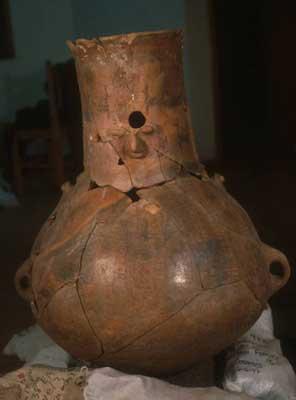
A large Lucre style face neck jar with conical base (87 cm tall by 60 cm diameter) (Photograph courtesy of Melissa Chattfield, Gordon McEwan and the Chokepukio Project).
Lucre style pottery is tempered with andesite in a way that closely resembles that of the Cuzco Inca ATF. The overall appearance of the ATF and the Lucre fabric is extremely similar (Wares 13 and 15, Lunt 1987, 163): in unstratified and undecorated material, they are difficult to distinguish from one another. The Lucre designs have their roots in the earlier Middle Horizon Period and, although they share the palette and rectilinearity, they differ in execution and arrangement from Killke designs, being boldly set four-square on the pot (McEwan 1987, 80,102–104; Chatfield 2007, 260; Fig. 2). The shapes include very large, pointed-based, face-neck jars and Chatfield likens their paste technology to that used for the Cuzco Inca aryballus (Chatfield 2007, 75).
Cuzco Inca wares have largely been studied, not as technical products or functional objects, but as vital chronological and cultural markers in provincial stratigraphies. For our purposes here, however, it is important to identify the various ceramic traditions that contributed to the creation of these wares and thereby to place them in a sequence of technological and stylistic development. Killke pottery offers several significant comparanda in its technology and style, but we should note that Rowe (1944, 61) and Bauer (2004, 74–75), inter alia, use this evidence, as well as distribution and stratigraphy, to identify the makers of Killke as ‘early Incas’, suggesting that the ceramic traditions reflect the socio-political development of the nascent Inca state. However, as described above, one of the most notable aspects of the Cuzco Inca potting technology, the exclusive use of andesite temper, is absent in Killke but is characteristic of Lucre. We now turn to the sources of andesite in the geology of the Cuzco region.
Andesite in the Cuzco Region
The Peruvian Geological Institute maps (INGEMMET 1999) identify Pleistocene outcrops of volcanic andesite from the Rumicolca Formation running from the south-east to the north-west of Cuzco see Map (Fig. 3). In the field there is some variation in the visual appearance of these andesites, and our initial work on the chemistry of these (see end-note) suggests that those to the south-east are somewhat different to those in the north-west.
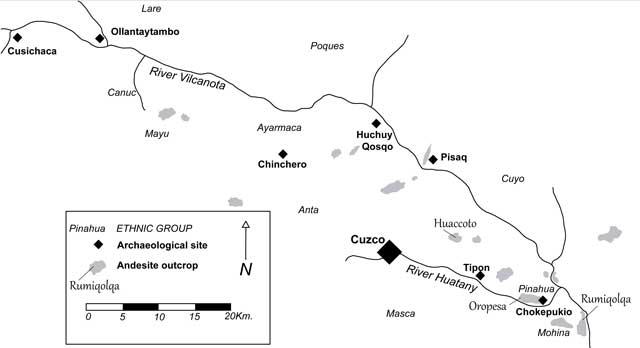
Map showing location of Rumicolca Formation Andesite outcrops, sites mentioned in the text, and approximate location of ethnic groups mentioned in early colonial texts.
Two of the Rumicolca Formation outcrops south of Cuzco supported ancient quarries. At Rumiqolqa (we follow Ogburn’s spelling to distinguish the quarry from the geological formation: Ogburn 2004, 439, n.3), there is plentiful and dramatic evidence of Inca quarrying with extensive debitage, partially and fully worked parallelepiped blocks (Fig. 4), and ramps to aid transport; there is further evidence of Inca stoneworking at Huaccoto. The outcrops to the north and west, were also quarried in the Inca period, although stone from these quarries seem to have been largely used for sites lying north of Cuzco (e.g. Chinchero, Huchuy Qosqo and Pisaq, Fig. 3).
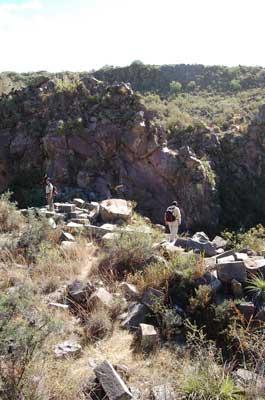
Inca carved andesite blocks within the Rumiqolqa quarry, Dennis Ogburn to the left and Julio Cesar Sierra to the right.
Protzen’s study of Inca stone-masonry was based on Rumiqolqa (Protzen 1985). He described the different qualities of andesite at various locales across the outcrop and then concentrated his attentions on one area of the quarry. Here, extensive evidence of Inca stone working survives, and Protzen (1985, 168) comments that one of the three qualities of andesite parallelepiped blocks found there ‘seems to correspond to….(one)…used in Cuzco’. Ogburn (2004), in his extraordinary work identifying the Rumicolca Formation as the source of the carved andesite found at Saraguro in Ecuador, characterised the Rumiqolqa and Huaccoto andesites geochemically. His results confirmed that the formation as a whole is chemically distinctive and that the andesites from these two sources had not yet been distinguished from one another (Ogburn 2004, 432).
In an article published in the first edition of the graduate journal Papers from the Institute of Archaeology, Hunt (1990) provided petrographic descriptions of these same andesites. He described the Rumiqolqa samples as ‘hornblende andesite, with primary phenocrysts of plagioclase feldspar, basaltic hornblende and biotite; there is a little pyroxene and occasional xenoliths of apatite and ilmenite’. The Huaccoto samples were described as ‘biotite andesite, with phenocrysts of plagioclase feldspar and biotite; hornblende is present but infrequent’ (ibid. 26, 27). Hunt matched these petrographical differences with differences in colour and physical properties, which served to distinguish between the products of the two quarries in the buildings of Cuzco and to confirm the Rumiqolqa origin of the imperial building stone. These are influential descriptions, which have been quoted subsequently (e.g. Bauer 2004, 157). We discuss and critique these below.
In 2013, the ridge of andesite between the pre-Inca site of Choquepukio (the principal source of Lucre pottery and of the ceramic samples used in our current work) and Oropesa was investigated (Fig. 3) There are signs of small-scale exploitation of this outcrop in modern times (chisel marks and dynamiting), but no conclusive evidence of ancient exploitation, such as worked stones left in situ. However, pre-Hispanic stone workers usually selected surface material, rarely employing extractive processes, and the occasional traces of debitage here may result from an early phase of low-key exploitation. The outcrop is the nearest surface source of andesite to Choquepukio, whose pre-Inca buildings are constructed from largely un-worked andesite field stone with some slight dressing on lintels and corner stones. The single Inca building on the site was also built with andesite and these blocks are more finely dressed in the familiar Inca manner.
Methods and Aims of the Study
Petrography is an analytical technique, originally developed by geologists, which studies minerals and their textural relationships using transmitted and/or reflected light. Prepared thin-sections of stone or pottery are viewed through a polarising microscope to record their optical properties and thus to identify the constituent minerals. By characterising and comparing the size, shape and quantity of inclusions in the clay body, we have direct evidence for how potters selected and prepared their raw materials. Such technological preferences, identifiable as distinct fabrics, can be interpreted as the products of different pottery making groups, so that the distribution and chronology of the pots made in each fabric will relate to the location, distribution and temporality of its makers.
In this paper ‘total petrography’, using both transmitted and reflected light (Ixer et al 2004), is used to characterise and compare the three principal fabrics used to make Killke, Lucre and Cuzco Inca pottery. The petrography of the tempering materials is then compared with that of geological samples from the Rumicolca Formation, with the aim of identifying the source of the andesite temper in the Cuzco Inca and Lucre fabrics. This is the essential evidence on which we base our ideas about how the temper was obtained and why it was chosen; and for discussing the transmission of a ceramic technology through time and between different production systems.
The origins of this study lie in an adventitious comparison made in 2001 between the petrography of a sample of andesite from an imperial building in Cuzco (Natural History Museum [NHM], Sample 1911 1506 (3), ‘Temple of the Sun’) and that of a sample of the ATF. Our petrographical analysis of the NHM sample (collected by persons unknown at some time before 1911), gave weight to an earlier idea, that the andesites of the ATF originated in the andesites of the Cuzco area (Ixer and Lunt 1991, 160); and it also provided a context for studying the similarities between the Lucre fabric and the ATF. We have had access to far fewer samples of Lucre pottery than of Killke and Cuzco Inca, but the results indicate the value of the approach.
The detailed petrography of the samples of ceramics and of the Rumiqolqa and Huacoto andesites has already been published (Ixer and Lunt 1991; Ixer et al 2014) and will only be summarised here. A very significant addition to that earlier corpus of material are two samples of andesite from the ridge between Oropesa and Choquepukio, collected by Sillar and Patrick Thompson and included in the latter’s Master’s dissertation (Thompson 2014). The petrography of these, and the conclusions based on them, are incorporated below.
Results
The Andesites of Rumiqolqa and Huaccoto
All the samples carry abundant biotite and plagioclase phenocrysts. They carry hypersthene in their groundmass, together with quartz xenocrysts and distinctive pleonaste/hercynite-corundum-bearing xenoliths. No amphibole group mineral (namely hornblende/basaltic hornblende/oxyhornblende) was identified and apatite phenocrysts were also absent (Fig. 6a).
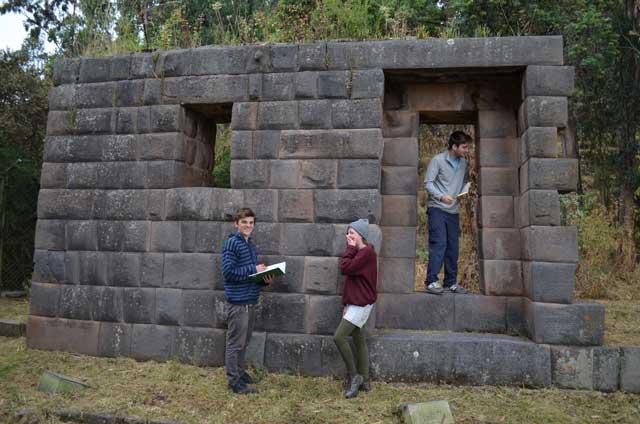
Sam Robertson, Sarah More and Patrick Thompson studying the use of close fitting andesite blocks at the Inca site of Qollcapata, Cuzco.
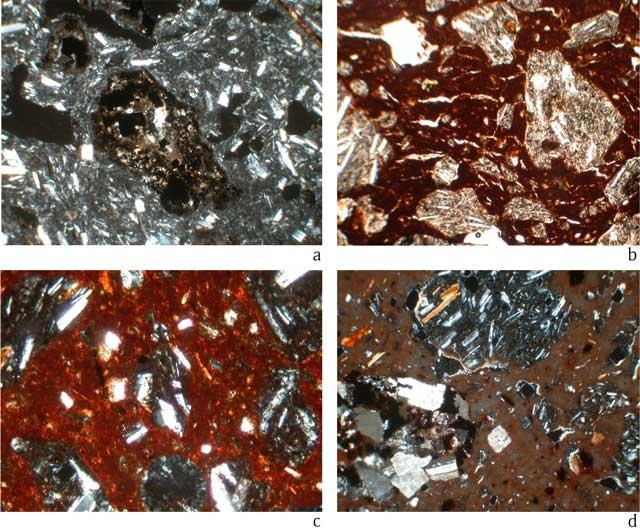
Micrographs taken at x40 magnification. a) Rumicolca Formation Andesite, sample R21: biotite- and biotite-pyroxene-bearing andesite with distinctive pleonaste-bearing xenoliths (in crossed-polarized light); b) Inca Andesite Tempered Fabric sample CUZ 99–4: restricted size range of sub-rounded to sub-angular biotite andesite within a clean clay (in plain-polarized light); c) Inca Andesite Tempered Fabric sample CUZ 99–3: showing hornblende (in crossed-polarized light); d) Lucre Andesite Tempered Fabric, sample CO97: tempered with angular to sub-angular biotite andesite, andesite with amphibole (hornblende) as well as a large sandstone clast/inclusion (in crossed-polarized light).
We have, as yet, been unable to identify any significant mineralogical difference between the andesite samples from Rumiqolqa and those from Huaccoto. Most significantly, with the benefit of more samples from both quarries than were available to Hunt, we see a total lack of amphibole or apatite. This is contrary to Hunt’s results, where, following Gregory (1916) he described hornblende phenocrysts as being more abundant than biotite in his Rumiqolqa samples, with pyroxene uncommon and apatite phenocrysts present. He contrasted this with his description of his Huaccoto, samples, where he stated that hornblende was rare.
It has not been possible to study Hunt’s original sections in order to explain the discrepancies between his and our petrographies. We can suggest, however, that the basal sections of biotite, and especially weathered biotite, show lines of dark, cross-hatched alteration that could readily be mistaken for the characteristic cleavage planes of amphibole.
The Oropesa Andesite
The two thin-section samples from this outcrop (S7L1S1; S7S1S5) are of a biotite-hornblende-bearing andesite with the full range of other ‘Rumicolca attributes’, including the presence of quartz xenocrysts and biotite-spinel-bearing xenoliths. This distinctive mineralogy is particularly noteworthy, as it matches that of one group of andesite temper used in the ATF and in Lucre: see Results below.
The Killke Fabric
Our current study confirms the lithologies described in Ixer and Lunt (1991) but reveals more variation in the materials used as temper. The most frequent materials are diorite and arkose/litharenite, both highly feldspathic, which appear together or alone; microporphyry, quartz sand and grog (which occurs alone or with other materials). The mean size of the temper grains, their general shape and their prevalence are broadly consistent across all the samples, regardless of type of temper.
The variations in the temper lithologies show some co-variance with decorative sub-style (Ixer and Lunt 1991; Ixer et al 2014). This suggests that Killke was made in a number of workshops, all employing a similar technology but using local materials, whose specific sources have not been located, to create the fabrics.
The Cuzco Inca Fabric
The ATF samples are tempered with sub-rounded to sub-angular/angular andesite in very clean clay. Most samples carry only trace amounts of chert/rhyolite, single quartz grains, fine-grained sandstone/arkose and mud clasts within the groundmass of the clay. All other rock types are extremely rare (Fig. 6b).
The dominant temper is hornblende-bearing andesite (27 samples; Fig. 6c), in which there is petrographical variation. The remaining 7 samples are tempered with biotite and biotite-pyroxene andesites (Fig. 6b), with some slight petrographical differences. Within a single sample, only one type of andesite occurs. The size, shape and quantity of the temper is extremely consistent throughout all the samples. There is no co-variance between the type of andesite temper and the size or shape of the parent vessel, its decorative sub-style, context or provenance.
The biotite and biotite-pyroxene andesite temper match the geological samples from Rumiqolqa and Huaccoto. In our earlier work (Ixer et al 2014), we stated that ‘the source for the hornblende-bearing andesites found in the ATF, which has not yet been recognised in the samples from Rumiqolqa or Huaccoto, is believed on petrographical grounds to be within the andesite outcrops north of Oropesa’. The match between the Oropesa hornblende andesite and the hornblende andesite temper of the ATF (and also that of Lucre, see below) is persuasive evidence that this may be the case.
The Lucre Fabric
The fabric is tempered with fresh, angular andesite. Two types of andesite occur: hornblende (5 samples) and biotite (6 samples), both displaying some petrographical variations (Fig. 6d). The tempering practice (grain size, shape and quantity) is the same for both types of andesite and similar in all the samples. Only one type of andesite occurs in any one sample. The sample size is too small to draw any conclusions about co-variance with other ceramic traits.
The biotite andesite within Lucre pottery can be matched with the samples from Rumiqolqa and Huaccoto. The hornblende andesite temper can be matched with the samples from Oropesa.
Discussion
The ATF Cuzco Inca fabric is highly standardised in its preparation, irrespective of the type of andesite used as temper. The different andesites cannot be distinguished in hand specimen and there is no co-variance with other ceramic traits, context or provenance. This suggests that, from a potting point-of-view, all of the andesites shared the same properties and we can therefore consider the ATF to be a single technological entity. Similar andesites exist in the Rumicolca Formation, where it crops out south of Cuzco at Rumiqolqa, Huaccoto and Oropesa.
The ATF was the dominant fabric used for Cuzco Inca pottery and for the entire range of forms, from the smallest bowls to the largest serving and storage vessels. It is important to note that other fabrics were also used for these wares, although they are far less common (Ixer and Lunt 1991).
Using a standardised fabric in a workshop guarantees consistency in working and finishing properties and in firing behaviour, all of which would be important if, as the visual appearance of Cuzco Inca wares suggests, uniformity was a goal of production. This relatively coarse fabric may have particular advantages when the pottery is being fired at high altitudes, in open fires, where the open-textured fabric facilitates successful oxidation (Lunt 1987, 49). The sharp-edged, angular grains of the andesite with their irregular surface topographies also make strong bonds with the clay which is particularly beneficial for the production of large jars (Ixer and Lunt 1991, 160).
The fabric preparation technology of Cuzco Inca pottery existed in the region before the development of the Inca state. It can be identified in Killke; and although the rocks used in the ATF and in the Killke fabric are entirely different, the use of clean clay and the introduction of plentiful rock fragments from a limited repertoire were common to both. However, the case for identifying Killke as a direct precursor to Cuzco Inca wares rests far more persuasively on its decorative style, relative date and distribution and not on its choice of temper and firing technology. In identifying a specific precursor for this, we must turn to another pre-Inca ware: Lucre.
As with the ATF, the andesites of the Lucre fabrics are indistinguishable in hand specimen and all were used in the same way, the grains being extremely similar in size, shape and quantity. The temper andesites can be matched in samples from the Rumicolca Formation, one of these being the Oropesa outcrop near Choquepukio, the principal finds-place of Lucre pottery
The petrographic comparison between the Lucre fabric and the ATF shows that the Lucre clays are less clean than the ATF, the degree of cleanness varies and much of the accessory material in Lucre is absent from the ATF. However, the similarities in temper are extremely striking. The Lucre fabric contains either hornblende-bearing or biotite andesites, identical to those in the ATF: this is persuasive evidence that the sources of andesite were the same. In both fabrics, the temper is used in exactly the same way: the grains are similar in size, shape and prevalence and there is only one type of andesite per sample. It seems clear, on this evidence, that the Lucre technique of sourcing andesite and using it in a pottery fabric was a significant element in the creation of Cuzco Inca pottery.
The viability of an andesite-tempered fabric was proven by its successful use for a wide range of Lucre wares, especially in the manufacture and serviceability of the large jars. From the view-point of technological pragmatism, it is suggested, therefore, following Chatfield (2007, 75, 81), that it was the desire to produce similar vessels that encouraged the transfer of this type of fabric from Lucre to Cuzco Inca pottery.
Petrographically, we can match the andesite temper used in the ATF and the Lucre fabric with andesite samples from the outcrops of the Rumicolca Formation south of Cuzco. Rumiqolqa and Huaccoto preserve good evidence for Inca and Spanish colonial stone workings; and the Oropesa andesites are the likely source of the andesite used at Choquepukio. But, however plausible the use of these sources for the ceramic temper may seem, it is essential to note here that we have not yet proven that they are the specific and only sources used by the pre-Incas and Incas. The known Rumicolca Formation andesites to the north and west of Cuzco have not been sampled and studied in depth, and other outcrops may exist: identification and characterisation of all potential sources is a primary aim of our on-going survey and analysis. Also, although the samples currently available show that the andesites of Huaccoto and Rumiqolqa are extremely similar, we will continue to investigate whether any petrographic or chemical compositional evidence can be found to distinguish between them.
Conclusions
Cuzco Inca pottery is a hybrid. Two distinct elements can now be identified, each contributed by wares that are dissimilar to one another in form and decorative style, although they share a pre-Inca date, some distributional over-lap, and a Cuzco-centric location. Identifying a precursor to Cuzco Inca pottery is hardly new – Killke has long held that position – but recognising the complexity of its origins is an advance and, whilst not refuting the Killke contribution, it does make the idea of a single strand of evolution, from Killke pottery to Inca pottery, untenable. There is now a clearer idea of what ‘Cuzco Inca’ comprises, which will illuminate how, where and when the creative process took place.
As to why it should have occurred: the archaeological evidence shows that Cuzco Inca pottery was created at the time of Inca state development; and that it occurs in administrative, elite and ritual contexts in Cuzco and throughout the empire. This suggests that it was being used as a proxy for the Inca state itself, as a political artefact. If this is so, then it is possible that the selection of elements to create it was also politically motivated, the ceramic representations of the subjugations and alliances that formed the Inca state. One of these elements, andesite, was also being used in the extensive building programme to create imperial Cuzco, and our evidence suggests that the sources of andesite for temper and for building may have been the same.
The andesite outcrops of Rumiqolqa and Oropesa lay in the territory of the Pinahua, a significant polity whose principal settlement was Choquepukio and who were the makers and users of Lucre pottery. They were subjugated by the Incas around 1430AD (McEwan et al 2002, Bauer 2004, 84–86), thus bringing the andesites under Inca state control. From this could flow the following outcomes: first, Inca access to the ceramic technology of the Pinahua and their ability to make very large vessels; secondly, a crucial date (albeit an estimate) ante quem for the introduction of an andesite-tempered fabric (the ATF) into the manufacture of Cuzco Inca pottery; and third, a plausible cultural context for this introduction: the subjugation of the Pinahua and the building of imperial Cuzco. To judge by the extensive quarrying evidence at Rumiqolqa, the use of this rock in the most prestigious imperial buildings of Cuzco and its exclusive use for state projects, the Incas valued their prize highly. The idea of ‘value’ may have resided in the physical properties of the andesite, but also in its exclusive availability to the Incas: an outward and visible sign of political domination.
We would then be presented with an intriguing scenario: a liaison between two state-controlled crafts. We must consider how this liaison might work in practical terms: the ceramic temper of the Pinahua could not have been a by-product of construction activity, as they rarely dressed their building stone. For the Incas, however, with their intensive building programme using dressed stone, andesite debitage would have been readily available, in a quantity appropriate to the newly-enhanced scale of state ceramic production.
In order to place this interpretation on a secure footing, we need, first, to expand our characterization of the Cuzco region andesites, in order to identify with confidence the specific sources of building stone used throughout the region. Secondly, we need to demonstrate which building stones and pottery tempers are from the same source. Were the hornblende and biotite/biotite-pyroxene andesites, used as ceramic temper, also used as building stone? If so, do their relative quantities in building projects match those found in the ceramic tempers of the ATF? Thirdly, we require independent dates from secure archaeological contexts, in order to date the first production of Cuzco Inca pottery and the commencement and development of the Inca’s programme to reconstruct Cuzco using fine-worked andesite.
Future work
In the early 2000s, Dennis Ogburn identified more than 450 finely worked andesite blocks, weighing between 200 and 700kg, which appeared to have been transported from Rumiqolqa to Saraguro in Ecuador, a distance of some 1,600 kms. Ogburn (2004) used X-ray fluorescence spectrometry (XRF) to compare the elemental composition of Rumiqolqa andesites with the blocks in Saraguro. Our collaboration with Ogburn arose from the possibility that petrography could contribute to the results of the elemental analyses: our petrography of six samples (PS1, PS2, PS3, PS4, PS5, PS6) characterize these as andesite with abundant biotite and plagioclase phenocrysts confirming the conclusions of Ogburn’s elemental analysis that the Saraguro blocks have the same composition as Rumicolca Formation andesite.
A collaborative project is now underway, using XRF and petrography to characterise the Rumicolca Formation andesites and the stone used in the imperial buildings in and around Cuzco. Preliminary work in 2011 focused on verifying the viability of using portable XRF equipment, so that building stone can be analysed in situ; and that results are not adversely affected by surface contamination (Ogburn et al 2013). This work continued in 2013 when Bill Sillar and Dennis Ogburn returned to Cuzco with two Institute of Archaeology undergraduates (Sam Robertson and Sarah More) and Patrick Thompson (from UCL, Earth Sciences) to undertake further sampling and characterisation of source materials and Inca building stone in the city of Cuzco (Fig. 5) and surrounding sites including Pisaq, Huchuy Qosqo, Sacsayhuaman, Chinchero, Tipon, and Ollantaytambo.
A fundamental problem for the archaeology of the city of Cuzco is the lack of a detailed chronology for the pre-Inca and Inca periods. The estimated date for the development of the ATF ceramics and the start of using andesite in construction projects is largely based on historical texts, whose relevance relates to a particular interpretation. However, C14 dates from excavations at Choquepukio (McEwan et al 2002) will provide the basis for a firmer archaeological sequence. Similarly, we cannot yet date with precision the introduction and synthesis of other materials, styles and techniques flowing into Cuzco from the provinces of the expanding empire. For this work we will continue our collaboration with other archaeologists working in the region, particularly with colleagues in the Ministry of Culture in Cuzco.

